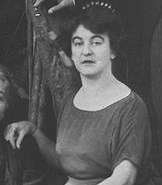Jeanne Leuba
Jeanne Leuba (8 November 1882, Paris – 24 July 1979, Lettenbach) was a French journalist, writer and poet. Having spent many years in Indochina and Cambodia, she is considered one of the most impressive of the women colonial novelists.[1]
Jeanne Leuba | |
|---|---|
 | |
| Born | November 8, 1882 Paris |
| Died | July 24, 1979 (aged 96) Lettenbach |
| Occupation | writer, journalist, poet |
| Language | French |
| Nationality | French |
| Spouse | Henri Parmentier |
Life
Jeanne Leuba was born on 8 November into a Parisian Protestant family. Her father was a well-known anatomical drawing artist A. J. Leuba. In childhood she was trained to become a concert pianist.[2] In 1905 she married Henri Parmentier, a director of EFEO (École Française d'Extrême Orient) archaeological service, and went with him to Indochina.[3] In the colony Leuba accompanied Parmentier in all his archaeological exploration treks in the local bush. From her diaries we know about the taxing conditions of their traveling. Many remote places that Parmentier wanted to study could be reached only by sampans, canoes, ox-driven carts or on foot.[2] Having diverse responsibilities ranging from technical assistance to mending of clothes and shopping for provisions, Leuba called herself her husband’s multi-task collaborator.[4]
She published several articles on the Angkor monuments and two books on the ethic group of Chams in Southeast Asia: Les Chams d’autrefois et d’aujourd’hui (1915), and Un royaume disparu: les Chams et leur art (1923).[4] In 1920s and 1930s Leuba was actively writing novels on Indochinese themes, including L’Aile du feu published in 1920.[5] Among all her writings best remembered are her collection of poetry La tristesse du soleil, discussed by Patrick Laude, and Le metis ensorcelle (1941), mentioned in general survey works on Francophone Indochinese literature.[4]
After Parmentier’s death in 1949 Leuba decided to remain in the colony. In 1945 she was detained in the Japanese concentration camp and after being released worked for the local French-language newspapers and the radio of Phnom Penh.[4] In 1954 Leuba prepared for publication posthumous work Parmentier L’Art de Laos. In 1966 she left Cambodia, where Cambodian Civil War was about to start, and settled in Austria where she remained until her death on 24 July 1979.[4]
Publications
- La Tristesse du soleil, Plon-Nourrit et Cie, 1913[6]
- Les Ruines d'Angkor, Imprimerie administrative, 1914
- Les Chams d'autrefois et d'aujourd'hui, La Revue Indochinoise, 1915[7]
- Pour un bijou, La Revue Indochinoise, 1917
- L’Ombre nuptiale, Plon-Nourrit et Cie, 1919[8]
- Loin du monde, La Revue Indochinoise, juin 1919, p. 563–573
- L'Aile de feu, Plon-Nourrit, 1920[9]
- Frick en exil, Perrin, 1923[10]
- Un royaume disparu. Les Chams et leur art, G. Van Oest et cie, 1923 (Preface of Louis Finot)[11]
- La Fin d'un roi cambodgien, Éditions de la revue "Extrême-Asie", 1928
- La Brève lumière, E. Flammarion, 1930[12]
- Le Personnel reconnaissant, Le Petit Écho de la Mode, no 37, 10 September 1933
- Le Métis ensorcelé. La Roue du temps. Condiments. Les Deux nuits de l'as de trèfle. Camille ou l'ingénue malgré lui, J. Aspar, 1941[13]
- Le Mystère de Bel-Abri. Le Rubis volé. La Servante des Aiguilles, J. Aspar, 1942[14]
- Écumes, J. Aspar, 1943[15]
- L'Art du Laos (with Henri Parmentier), Imprimerie Nationale (Publications of l'École Française d'Extrême-Orient), 1954[16]
- Angkor. Guide Henri Parmentier (with Henri Parmentier), E.K.L.I.P, 1960[17]
References
- Bingaman, Amy; Sanders, Lise; Zorach, Rebecca (2003-12-16). Embodied Utopias: Gender, Social Change and the Modern Metropolis. Routledge. ISBN 978-1-134-53756-3.
- Ha, Marie-Paule (2014). French Women and the Empire: The Case of Indochina. Oxford University Press. p. 211. ISBN 978-0-19-964036-2.
- Soria, José Luis Ferrer (1999-01-01). Ma part d'Afrique: récit (in French). KARTHALA Editions. p. 134. ISBN 978-2-86537-978-1.
- Ha, Marie-Paule (2014). French Women and the Empire: The Case of Indochina. Oxford University Press. p. 212. ISBN 978-0-19-964036-2.
- Robson, Kathryn; Yee, Jennifer (2005). France and "Indochina": Cultural Representations. Lexington Books. p. 6. ISBN 978-0-7391-0840-6.
- Leuba, Jeanne (1913). La tristesse du soleil (in French). Paris. OCLC 66838105.
- Leuba, Jeanne (1915). Les chams d'autrefois et d'aujourd'hui (in French). Hanoi [North Vietnam: Imprimerie d'Extrême-Orient. OCLC 904150166.
- Leuba, Jeanne (1919). L'ombre nuptiale: roman (in French). Paris: Plon-Nourrit et Cie. OCLC 62099271.
- Leuba, Jeanne (1920). L'aile de feu roman (in French). Paris: Plon-Nourrit. OCLC 678910063.
- Leuba, Jeanne (1923). Frick en exil (in French). Paris: Perrin. OCLC 458187813.
- Leuba, Jeanne (1923). Un royaume disparu: les Chams et leur art; (in French). Paris; Bruxelles: G. Van Oest et cie. OCLC 1081246.
- Leuba, Jeanne (1930). La Brève lumière: roman (in French). Paris: E. Flammarion. OCLC 78308798.
- Leuba, Jeanne (1941). Le métis ensorcelé (in French). Saigon: J. Aspar. OCLC 1924850.
- Leuba, Jeanne (1942). Le Mystère de Bel-Abri. Le Rubis volé. La Servante des Aiguilles (in French). Saïgon: J. Aspar (impr. de J. Aspar). OCLC 459637565.
- Leuba, Jeanne (1943). Ecumes ...: roman (in French). Saigon: J. Aspar. OCLC 1919952.
- Parmentier, Henri (1954). L'Art du Laos, etc. Pp. iv. 364. pl. 120. LI. Hanoi. OCLC 563589514.CS1 maint: location (link)
- Parmentier, Henri; Leuba, Jeanne (1960). Angkor: guide Henri Parmentier (in French). Phnom-Penh: E.K.L.I.P. (anciennement Albert Portail). OCLC 810275881.